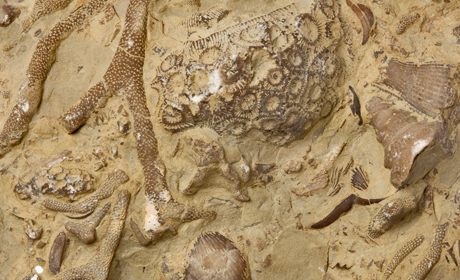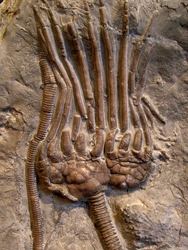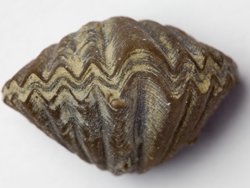Wren’s Nest
Dudley, West Midlands, England

Wren's Nest Hill was declared a National Nature Reserve in 1956 (one of the first for geology in the U.K.), with the Mons Hill extension being added in 1957. The establishment of the Reserve was in recognition of the exceptional, international importance of the site as a source of Silurian (Wenlock) age fossils.
 Wren's Nest has yielded
a great variety of both macro and micro fossils of superb preservation, the best of which are
to be found in museums throughout the world, and illustrated in many publications.
Wren's Nest has yielded
a great variety of both macro and micro fossils of superb preservation, the best of which are
to be found in museums throughout the world, and illustrated in many publications.
Wren's Nest is the middle of three related limestone hills (Castle Hill to the south-east and Hurst Hill to the north). They all form conspicuous steep sided features, and Castle Hill and Wren's Nest, being substantially wooded, rise "like green islands out of the dark sea" of the coal-bearing rocks of the South Staffordshire Coalfield which surround and separate them.
The folded layers of the Much Wenlock Limestone Formation (formerly known as the Dudley Limestone) which form the hills, have been quarried or mined for hundreds of years.
 Until
the seventeenth century the limestone was used principally in agriculture and later in the early
iron industry of South Staffordshire. At the end of the eighteenth century and throughout the
nineteenth century output of limestone soared to serve the expansion of the local Black
Country iron industry.
Until
the seventeenth century the limestone was used principally in agriculture and later in the early
iron industry of South Staffordshire. At the end of the eighteenth century and throughout the
nineteenth century output of limestone soared to serve the expansion of the local Black
Country iron industry.
Limestone extraction, however, declined before the First World War, and mining at Wren's Nest finally ceased in 1924.
 The nineteenth century was the most
prolific period for the supply of fossils, for which there was a ready market, providing
welcome, if not illicit, extra income for the miners. The size of the trade may be judged by
the existence of three fossil shops in Dudley at one time.
The nineteenth century was the most
prolific period for the supply of fossils, for which there was a ready market, providing
welcome, if not illicit, extra income for the miners. The size of the trade may be judged by
the existence of three fossil shops in Dudley at one time.
Wren's Nest is still an abundant source of fossils, although it is unusual to find complete, perfect specimens such as those seen in Dudley Museum & Art Gallery, most of which were collected many years ago.
 The Reserve, which attracts thousands of visitors a year, is
universally recognised as an outstanding outdoor teaching resource, suitable for all ages and
levels of study, which could be seriously damaged by unrestricted use.
The Reserve, which attracts thousands of visitors a year, is
universally recognised as an outstanding outdoor teaching resource, suitable for all ages and
levels of study, which could be seriously damaged by unrestricted use.
Hammers are prohibited and collecting, which is regulated, is allowed only from the abundant scree. The fossil collecting code for visiting parties is included in the downloads.
Related Links
- Guide to Wren's Nest from Dudley Council
- Fossil Guide and Collecting Code (pdf)
- Wren's Nest Nature Reserve
Images (top to bottom):
- Fossil corals from Wren's Nest © Graham Worton
- An exceptionally well-preserved Crinoid © Graham Worton
- Bryozoan © Graham Worton
- Rugose Coral © Graham Worton
- Brachiopod © Graham Worton

October 13 - 21
Theme: 'Earth Science in our lives'
